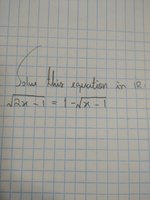Can't solve this equation ,pls help
- Thread starter AndreH383
- Start date
Dr.Peterson
Elite Member
- Joined
- Nov 12, 2017
- Messages
- 16,822
There are several typical mistakes people make on these, so we can't tell which one you're making without seeing your work (in some detail).Hello guys, I just started studying irrational functions and I'm stuck at this equation. The solutions say the result is X=1 but I can't seem to get there.
View attachment 27622
That's a big reason we ask you to show work:
Posting Guidelines (Summary)
Welcome to our tutoring boards! :) This page summarizes main points from our posting guidelines. As our name implies, we provide math help (primarily to students with homework). We do not generally post immediate answers or step-by-step solutions. We don't do your homework. We prefer to help...
www.freemathhelp.com
Just out of interest
[MATH]\sqrt{2x-1}=1-\sqrt{x-1}[/MATH]
[MATH]\sqrt{x-1}[/MATH] shows that [MATH]\boxed{\;x≥1\;}[/MATH]
[MATH]\sqrt{2x-1}=[/MATH]1-[MATH]\sqrt{1-x}[/MATH] means [MATH]2x-1≤[/MATH]1 [MATH]\text{ so }\boxed{\;x≤1\;}[/MATH]
[MATH]x≥1 \text{ and } x≤1 \text{ so } x=1.[/MATH]
Now check to see if x=1 is a solution of the original equation - which it clearly is.
[MATH]\sqrt{2x-1}=1-\sqrt{x-1}[/MATH]
[MATH]\sqrt{x-1}[/MATH] shows that [MATH]\boxed{\;x≥1\;}[/MATH]
[MATH]\sqrt{2x-1}=[/MATH]1-[MATH]\sqrt{1-x}[/MATH] means [MATH]2x-1≤[/MATH]1 [MATH]\text{ so }\boxed{\;x≤1\;}[/MATH]
[MATH]x≥1 \text{ and } x≤1 \text{ so } x=1.[/MATH]
Now check to see if x=1 is a solution of the original equation - which it clearly is.
Last edited:
D
Deleted member 4993
Guest
Following Jomo's advice:Hello guys, I just started studying irrational functions and I'm stuck at this equation. The solutions say the result is X=1 but I can't seem to get there.
View attachment 27622
√(2x-1) = 1 - √(x-1) .............(1)................ square both sides
(2x-1) = 1 + (x-1) - 2*√(x-1) ................. simplify
2√(x-1) = 1 - x ........................................... square both sides
4(x-1) = 1 + x^2 - 2x .............................simplify
x^2 - 6x + 5 = 0 ......................................factorize
(x - 5)(x - 1) = 0 ....................................... two solutions: x = 5 and x = 1
Assuming √ is always positive → x =5 ............... here x=5 is an extraneous solution (created due to 'squaring')
The other solution: x = 1 satisfies the given equation (#1).
Hence the solution is x = 1.
The method shown above will always produce a solution, if solution/s exist (along with - may be - extraneous solution, which you need to discard). Although Lex's method in response #4 is very clever and concise, it is difficult to 'see' for some problems. ......................edited
Last edited by a moderator:
Steven G
Elite Member
- Joined
- Dec 30, 2014
- Messages
- 14,591
Simply brilliant!Just out of interest
[MATH]\sqrt{2x-1}=1-\sqrt{x-1}[/MATH]
[MATH]\sqrt{x-1}[/MATH] shows that [MATH]\boxed{\;x≥1\;}[/MATH]
[MATH]\sqrt{2x-1}=[/MATH]1-[MATH]\sqrt{1-x}[/MATH] means [MATH]2x-1≤[/MATH]1 [MATH]\text{ so }\boxed{\;x≤1\;}[/MATH]
[MATH]x≥1 \text{ and } x≤1 \text{ so } x=1.[/MATH]
Now check to see if x=1 is a solution of the original equation - which it clearly is.
Steven G
Elite Member
- Joined
- Dec 30, 2014
- Messages
- 14,591
Subhotosh, sorry but that is simply not true. As you said, maybe with an extraneous solution. That implies, since we have a quadratic equation, that there may not be any extraneous solutions which implies that there can be two solutions. If there can be two solutions, then there will be an equation that has NO solutions.The method shown above will always produce a solution (along with - may be - extraneous solution, which you need to discard).
Always be careful when you say will always.
This error really deserves some corner time to think about this!
I suppose it is good to practise thinking skills by trying to look at things differently. (It's also fun)!
[MATH]\sqrt{1-2x}=[/MATH]1-[MATH]\sqrt{1+x}[/MATH]
so [MATH]1-2x≤1[/MATH] i.e.[MATH] \boxed{\;x≥0\;}[/MATH]
[MATH]1-\sqrt{1+x}=\sqrt{1-2x}≥0[/MATH]
so [MATH]\sqrt{1+x}≤1[/MATH], so [MATH]\boxed{\;x≤0\;}[/MATH]
[MATH]x=0[/MATH] is the only possible solution, but clearly is not a solution of the original equation.
Therefore, no solution.
[MATH]\sqrt{1-2x}=[/MATH]1-[MATH]\sqrt{1+x}[/MATH]
so [MATH]1-2x≤1[/MATH] i.e.[MATH] \boxed{\;x≥0\;}[/MATH]
[MATH]1-\sqrt{1+x}=\sqrt{1-2x}≥0[/MATH]
so [MATH]\sqrt{1+x}≤1[/MATH], so [MATH]\boxed{\;x≤0\;}[/MATH]
[MATH]x=0[/MATH] is the only possible solution, but clearly is not a solution of the original equation.
Therefore, no solution.

